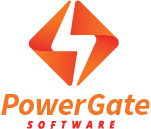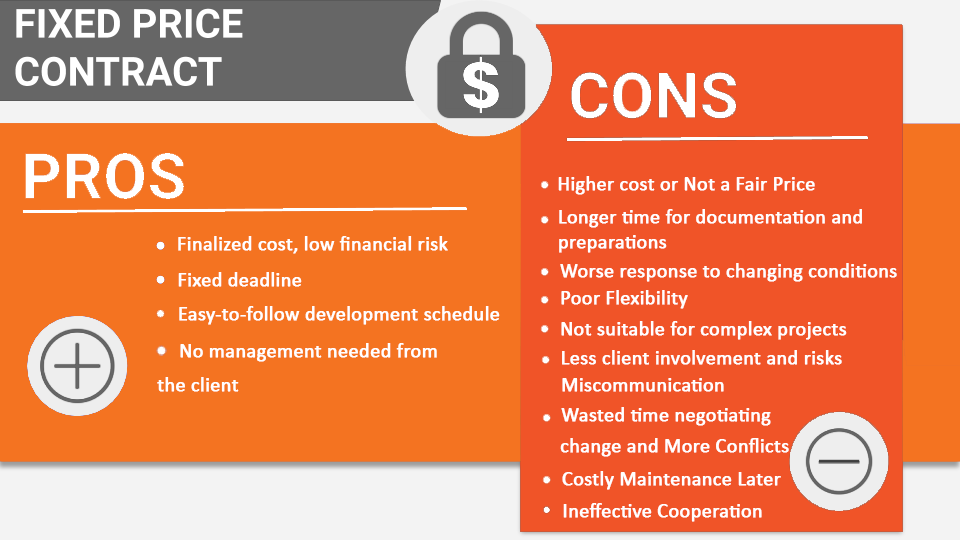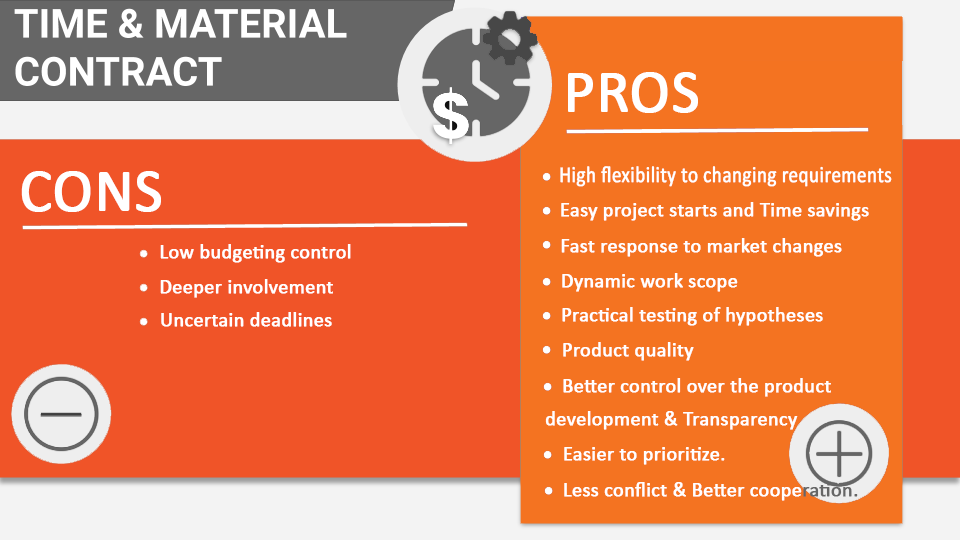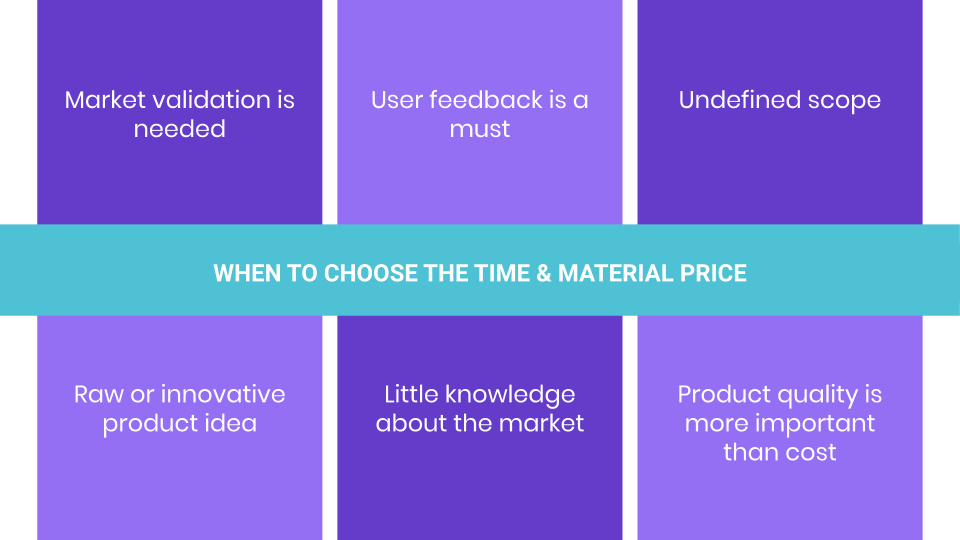Team (T&M) vs Fixed-Price: How to Choose the Suitable Project Model for You
When you decide to bring your product idea to life, questions are bound to appear everywhere. How can you begin the process of product development? Who should you work with? How much will it cost?
One of the toughest questions to answer is which type of software contract you should go for when working with a developer company.
In the product development industry, there are two major pricing models: Team (T&M) and Fixed-Price. Both have pros and cons, and choosing the right one can seem tricky. So, to help you decide, we listed all of the specific elements and used specific cases to illustrate the advantages and disadvantages of each pricing model.
1. What is a fixed-price contract?
For a fixed-price project, a vendor prepares a project quotation that defines a complete scope of work and the cost and timelines for its delivery upfront. The fixed-price contract naturally aligns with the Waterfall project methodology, where each stage follows after the previous one is finished. You pay the cost in installments as the project unfolds, with the payment schedule usually dictated by the project’s milestones and duration.
2. Fixed-Price Advantages
* Finalized cost, low financial risk. After the project cost is set in the contract, you will know exactly how much you’ll pay. The software company cannot overcharge you without prior notice. With this contract model, the risk of overspending your budget is basically zero.
* Fixed deadline. With a final scope and detailed features, the development team can better estimate the timeline for the project. Based upon that, they can come up with a clear plan and definite deadlines.
* Easy-to-follow development schedule. You’ll know which features will be implemented at any given point during the project. You’ll also be able to tell if there’s a delay in the delivery.
* No management needed from the client. Since the project details are all set, you can hand over project management responsibilities to the developer team. There’s no need for continuous supervision from your side so you can keep your participation to a minimum.
3. Fixed-Price Disadvantages
* Higher cost or Not a Fair Price
A Fixed-Price doesn’t mean a fair price. In a fixed-price model, programmers must estimate the work when they have minimum knowledge about a product. So even if a coding team acts in good faith and does its best, odds are their quote will be unrealistic. For instance, it will be hard for developers to accurately quote the functionality that is unknown to them. Neither is it possible to provide the estimation for the changes which will be required due to some future circumstances.
Basically, this means that the price mentioned in a contract won’t be fair either way. Specifically, if it takes developers less time to complete the work than it was originally expected, a client will overpay. On the other hand, an outsourcing company may earn nothing or even have some financial losses if it underestimates the project. In such a case, a client will suffer as well – a product will doubtedly have a high quality since it is created in a rush.
* Longer time for documentation and preparations
Writing specifications is hard and takes a lot of time. Thinking through all the details of a project in advance is time-consuming, even if you are an expert and have done it a hundred times before. It’s reasonable to expect that expertise from developers, but writing a specification has to be a collaboration and time dedicated to it up front by you, the client.
If you find yourself in a time crunch to deliver your product, this contract model is not for you. Long planning is required to estimate the most accurate price for the software that will be developed. But that can be a potential drawback when it comes to short deadlines. And still, we might not avoid some communication misunderstandings while the project is ongoing.
* Worse response to changing conditions
If the market situation suddenly changes – there is only a place for adjustments within the budget and that might be tight considering the mentioned plan written beforehand. Also, if the client gets an idea that would be much more beneficial for the business – it might not be possible to introduce it within the price of a Fixed-Price contract.
* Poor Flexibility
After you sign the contract, there is no easy room for changing or adding features. Let’s say that the Many clients insist on setting the budget before a project starts because they know exactly how the final product should look like. Or, better to say, they think they know it. But, in fact, it’s a mere delusion. In software development projects, there is always a factor of requirements volatility. It means that market conditions and user expectations will inevitably change. And if the feature prioritization is not adjusted to these changes, the project will likely fail.
At the same time, the parties are usually reluctant to amend a fixed-price contract since most new terms require signing another agreement and lead to additional costs. That’s why developers usually try to build a product that was defined at the very beginning rather than the best product possible. As you may guess, such an approach rarely ends up with the project success.
* Not suitable for complex projects
With smaller projects, the fixed-price model works well. However, if your product is more complex ,like an e-commerce website or a multi-platform mobile app, the fixed model will be too rigid. Products with complex functions, dependencies, and long implementation need constant review, modification, and flexibility.
* Less client involvement and Miscommunication risks
To work well in a fixed-price model, clear and straightforward communication is a must. If you miss a detail or the project specifications aren’t clear, you can easily receive something different than what you expected. Also, a potential advantage, the reduced need for client involvement once the specification has been agreed, can result in isolated development where the end product, although it technically meets the requirements, does not meet the client expectations.
* Wasted time negotiating change and More Conflicts
If requirements do change during a project, and in 99% of cases there will be some change, time that could otherwise be spent building your site gets sucked into negotiating instead.
* Costly Maintenance Later
You can buy utensils once and then use them for ages. But software solutions aren’t anything like this. New technologies are evolving at a rapid pace so websites and mobile apps need constant maintenance. This, of course, refers to all digital products created under different cooperation models. However, the solutions built according to a fixed-price arrangement will require updates faster and they will probably more expensive.
The reason is obvious. As we’ve already mentioned, such solutions are developed according to predefined requirements without taking into account current conditions. To become relevant, they have to be upgraded not long after the initial release. Also, if the quality was compromised due to a wrong estimation of the project, further maintenance will be more complex and, thus, more expensive.
* Ineffective Cooperation
To complete a project successfully, a client and a development team must be on the same page. But it’s not the case of a fixed-price contract. Every party in this type of arrangement has its own interests which often contradict with the interests of another party. In particular, a client wants to receive a top-notch product at the price fixed in a contract. At the same time, developers usually just want to tick the boxes on the feature list.
As all the participants of a project treat it differently, a fixed-priced model doesn’t work well in terms of transparency, communication, and overall cooperation. A coding team isn’t interested in disclosing to a client any issues discovered during the development process. At the same time, a client is motivated to get as much as possible without increasing the price.
4. When Should You Choose The Fixed-Price Model?
• If you know exactly what you’d like to build
• If your project is small with limited features
• If you are making an MVP
• For shorter projects that take about 3-5 months
• When you have a definite deadline
All in all, the fixed-price model has its benefits. However, it is not the ideal option when dealing with software product development. Creating software product that users love takes continuous testing and iteration, and there’s little to no room for experimentation when operating under a fixed-price contract.
II. THE TEAM (T&M) MODEL
1. What is a Team (T&M) contract?
With team (T&M) pricing, you pay for the real time spent on building the application. It’s a flexible solution which allows you to make changes to the product, alter priorities, shuffle features, pivot and react to market and user needs.
2. Team (T&M) Advantages
* High flexibility to changing requirements
The work process in Team (T&M) model is open for changes and adjustments. Adding, removing and improving every feature to get the viable effect is not a problem if the client has a budget.
* Easy project starts and Time savings
You don’t need a final, detailed product requirement documents and detailed project plan. You merely need to define the scope with the team and the minimum viable features to start the development.
Team (T&M) projects don’t require as formal a ‘change request’ process – which can involve discovery, estimation, negotiation, etc. Instead, a more agile approach can be taken with quick tests and iterations.
3. Team (T&M) Advantages
* High flexibility to changing requirements
The work process in Team (T&M) model is open for changes and adjustments. Adding, removing and improving every feature to get the viable effect is not a problem if the client has a budget.
* Easy project starts and Time savings
You don’t need a final, detailed product requirement documents and detailed project plan. You merely need to define the scope with the team and the minimum viable features to start the development.
Team (T&M) projects don’t require as formal a ‘change request’ process – which can involve discovery, estimation, negotiation, etc. Instead, a more agile approach can be taken with quick tests and iterations.
* Fast response to market changes
You’re able to make any change required to make the product a success. For example, let’s say you planned to integrate Facebook login to your application, but it turned out that your users do not use Facebook. You can leave out the feature and implement something more valuable for your users. There’s no need for negotiation or meticulous planning.
* Dynamic work scope
With larger projects, the main priority is to have a general goal of what you want to achieve. Knowing exactly how the goal can be achieved is rarely known in the beginning. In our experience, for startups and SME it is better to make decisions throughout the process. This way the strategy and the product can evolve based on market feedback.
* Practical testing of hypotheses
You can avoid building something nobody wants by creating a quick MVP and testing it out with real users. This allows you the opportunity to iterate the scope based on their feedback. With the fixed-price model, the list of features is set in stone from the beginning, and there’s no room or flexibility for this kind of validation.
* Product quality
Continuous iteration and user testing help to create a product that is as near to perfection as possible. With a high-quality software, your users will be much happier and much more likely to return to you.
* Better control over the product development & Transparency
Team (T&M) pricing model is often used in Agile development, as it gives the client a possibility to be a part of the work. That usually means sprints, iterations and meetings organized regularly to discuss the progress and next steps. You will have access to as much information about the project as you want. We personally like to have regular planning meetings and product demos so that clients can keep track of the product’s progress.
* Better control over the product development & Transparency
Team (T&M) pricing model is often used in Agile development, as it gives the client a possibility to be a part of the work. That usually means sprints, iterations and meetings organized regularly to discuss the progress and next steps. You will have access to as much information about the project as you want. We personally like to have regular planning meetings and product demos so that clients can keep track of the product’s progress.
* Easier to prioritize
Not sure which feature to start with or which will provide optimal value to users? Should you start with simple or more complex tasks? With the Team (T&M) contract, you have the room to experiment and change directions as many times as you need. A Team (T&M) contract encourages teams to prioritize tasks. This means that the most important, mission-critical, tasks are tackled first, and less important, but potentially tricky tasks don’t derail the project.
* Less conflict & Better cooperation
Without the ‘scope-creep’ discussions, a Team (T&M) project keeps everyone focused on the project goals and not debating over what is in or out of scope.
4. Team (T&M) Advantages
* Low budgeting control
Since the scope of the project is not defined in detail, you cannot know the exact final cost of the product will be. Only an approximate amount can be predicted based upon the estimated work hours
* Uncertain deadlines
As the product can change according to market needs, it’s quite hard to define an exact release date. That’s why setting milestones is so important for this kind of cooperation.
* Deeper involvement
This may not be a disadvantage if you have the time and commitment to build your product. However, if your time and your involvement are limited, it can result in delays. In this model, you have to be able to make decisions about the product regularly so the product team can move forward in the right direction.
5. When Should You Choose The Team (T&M) Model?
• When you want to be sure you’re building something that has a market need
• If you plan to create something where user feedback is a must
• If the scope of your product is undefined and defining it would take more time than the development itself
• You have a raw or innovative product idea
• When you know very little or nothing about your target market
• When the quality of the product is more important than the cost
TAKEAWAYS
A good client-provider relationship is the keystone of software development. Since money is often the #1 source of tension in a work agreement, a contract that is beneficial for both parties can lay a solid foundation for their cooperation. With the right type of contract, both parties can minimize risks and increase the chances of a positive outcome.
In the last 10+ years, we’ve created over 150 products in both fixed and Team (T&M) models. Personally, we believe that the Team (T&M) model is the best way to go if you want a high-quality, lovable product.





